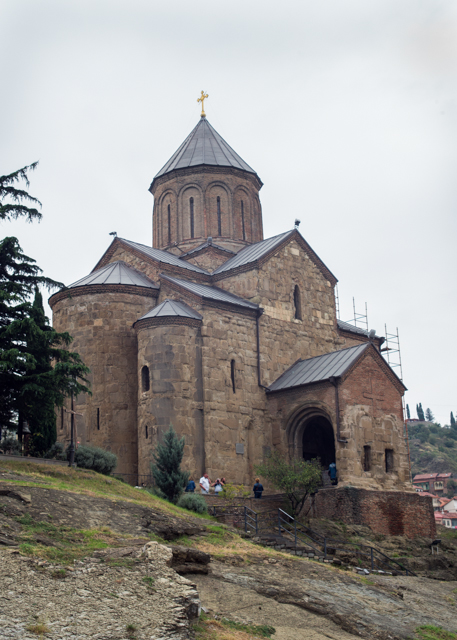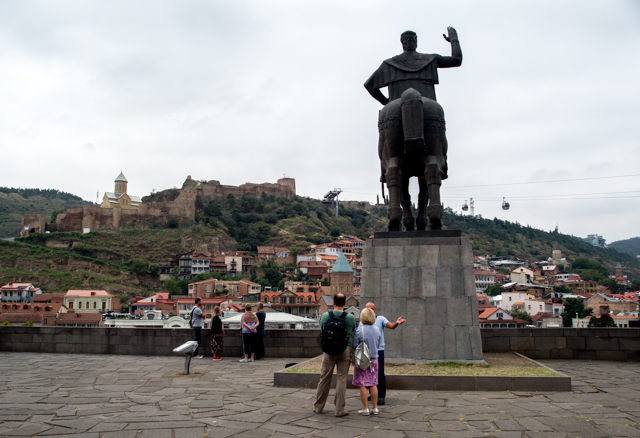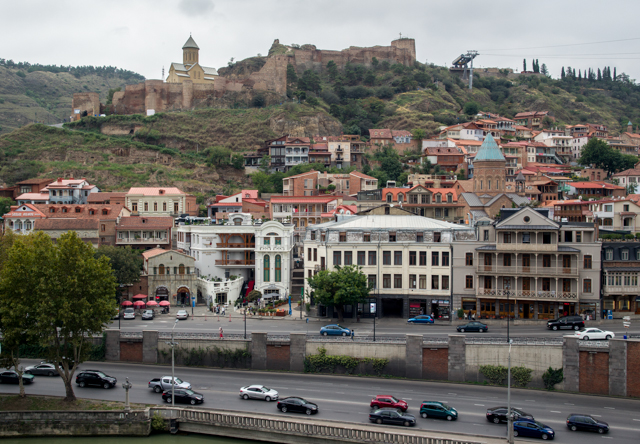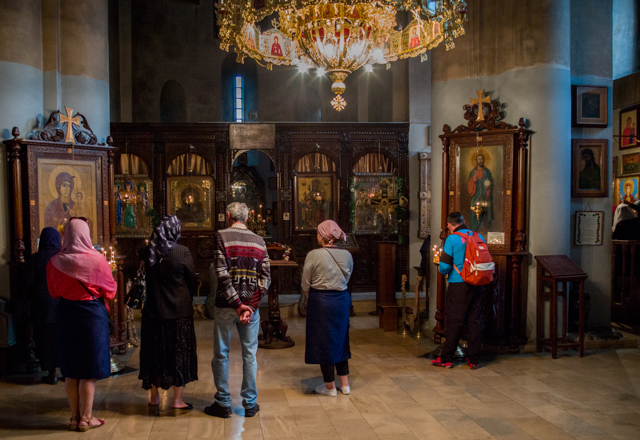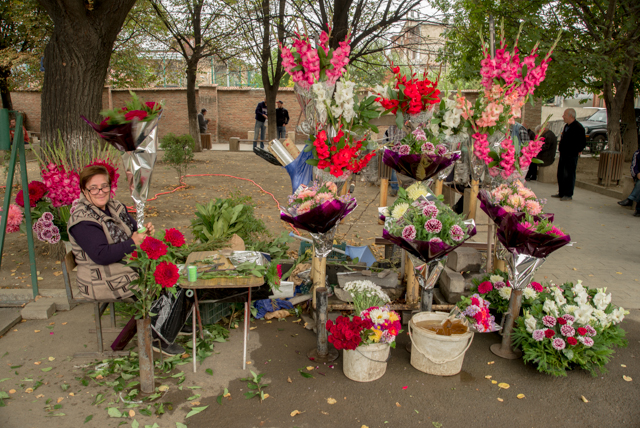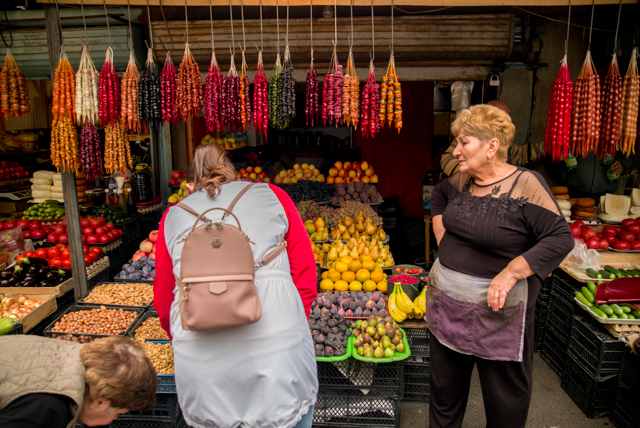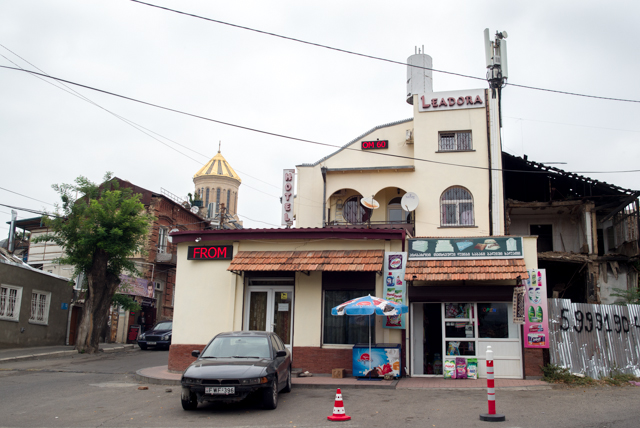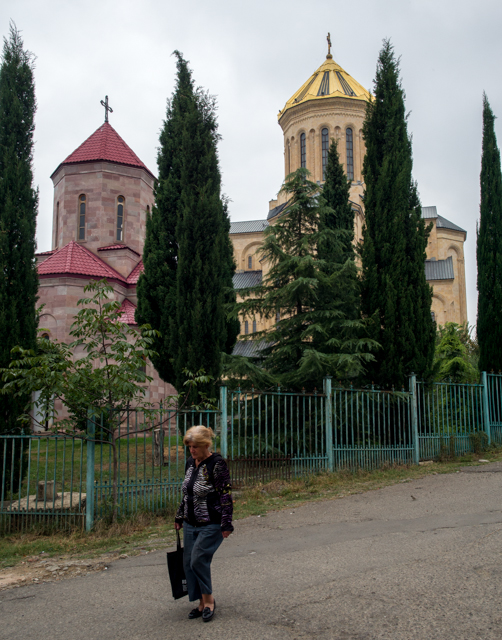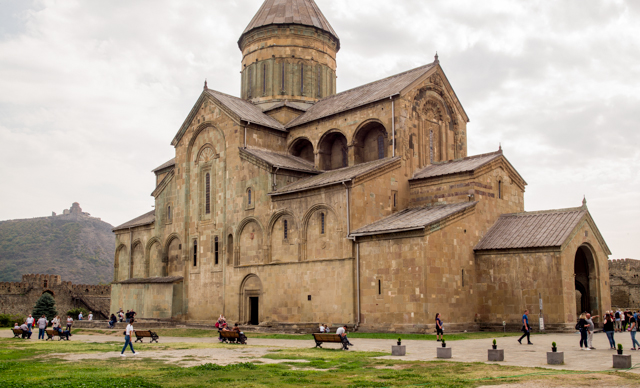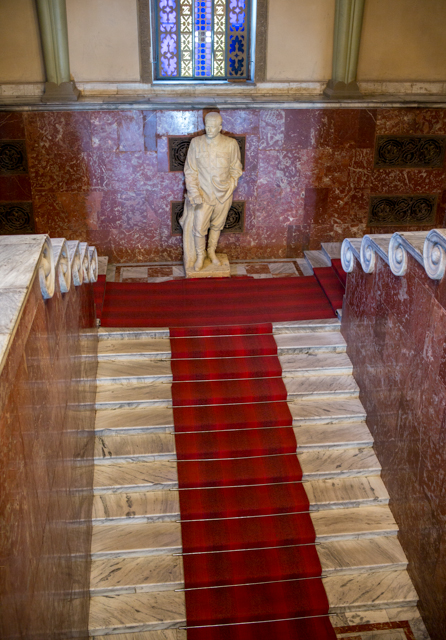The air route from Istanbul to Tbilisi is over the Black Sea for most of the distance. When it reaches Georgia, the moist, verdant coastal region rapidly gives way to a drier climate that reminded me of parts of New Mexico. This part of Georgia extends, interrupted a few times by low, conifer-covered mountains, and becoming progressively drier, to the border with Azerbaijan. The region is in a rain shadow of the towering Caucusus Range that spans Georgia's northern border with Russia.
The Tbilisi airport is a smallish one but very new and modern. Passport control was easy to pass, though we first needed to clear a surprising security screening. Screening to get into parts of an airport from inside a country is routine, but I've not before been where arriving passengers are screened, too.
Regina had a minute or two of panic after passport control when she tried to replace her passport in her hidden wallet but couldn't find it. That wallet also contains things like US $, credit cards, a medication list, etc, and we carry them looped around our belt and hidden away inside our trousers. The panic soon ended, however, when we remembered that, while carrying our passports in our hands, we were obliged to remove our belts for the security. Without her belt, Regina's wallet had dropped down her pants leg where she found it to end the panic attack.
We got some Georgian cash from an ATM and then walked outside to find a ride into Tbilisi. The weather was pleasantly warm, as it would be for our entire visit. There were many taxis along the curb, and each driver would beckon to us as we passed by. But we were headed to the bus stop, planning to take the #37 bus into town. There seemed to be no kiosks at all along the curb where we could buy bus tickets as is common in most of the other post-Soviet Republics where we have previously traveled, but we forged ahead, confident that something would work out. As we reached the bus which stood waiting, we were approached by a youngish man who spoke a little English and who offered to take us to the city. When I told him that we planned to go on the bus, he scoffed and said that the city is a very long way, and that the bus takes a very long time. So I asked, "How much?" He said, "$15." I asked for his price in Gel (the local currency). He said, "30 Gel." I said, "No," having read that 20 Gel is the going rate. He asked, "How much?". I said, "20 Gel." He said, "25." I said, "OK," and we climbed into his car.
He was right. It was a very long way into central Tbilisi. After perhaps 20 minutes at high speed we entered the city. We had given him the name of the hotel where we had reservations, and he consulted his phone to find where to deliver us. After many twists and turns through city streets, he stopped at a tall, plywood wall. I could see a large newish building over the top of the wall and a construction site across the "street" from it. Undaunted by this unexpected circumstance, I noticed a "doorway" through the wall, and after paying our driver, we walked through the "doorway" and found the very new and comfortable Hotel Pirimze. I have no idea whether I could have succeeded to take a bus into the city from the airport and then to find this place without eventually hiring a taxi.
After a rest, we went out looking for dinner at about 8pm. Walking along the busy Pushkin Boulevard, we stopped first at a basement establishement whose menu offered grilled salmon (Regina's go-to meal). That place turned out to be a "club" with loud music, very sweet "dry" white wine and no salmon. We continued up the boulevard to the large Freedom Square but saw no restaurants. Heading then along Rustaveli avenue, we spied a very new, mulit-storied shopping mall, and inside on the fourth floor we found an Italian restaurant. Regina got her grilled salmon and we ate a good (but expensive by Georgian standards) meal for 120 Gel (about $47).
We went out next morning to explore Tbilisi. A long, narrow, tree-covered street led us from Freedom Square to Meidan Square, an unimpressive square at the center of the Old Town. After crossing the Mtkvari River, we climbed up onto a rocky bluff overlooking the river where the 13th Century Metekhi Church occupies the site of an early Georgian Christian church of the 5th Century CE.
The plaza outside the church contains the equestrian statue of the 5th Century King Vakhtang Gorgasali who built his castle there. Across the river is the Narikala Fortress on a still higher mountain. It originated as a Persian fortress in the 4th Century CE.
A mid-morning service was underway when we entered the Metekhi Church. The inside walls and especially the iconostasis are adorned with many, very old-looking, icons. A crystal chandelier bearing still more very small icons hangs above the few faithful attending the service. A three-woman chanting choir, hidden behind a column at the right of the room, repulsed my approach to photograph them, but I encountered no objections as I made a few other photos.
At the time of the photo here, the priest was at the altar behind the iconstasis where only the ordained may go, while the choir led the service. Then the woman at center in the red scarf began to sing/chant in a crystal clear soprano voice that filled the small church and stimulated echoes from the high stone walls and the dome far above her. Finally, a large, bearded priest emerged from the altar space. He was dressed in ornate robes and swung a censor to and fro making its incense-scented smoke drift about in ephemeral white wreathes. He mumbled a few well-rehearsed phrases then retreated again behind the iconostasis, and the service ended.
We left the church and climbed the hill out of the river valley, and soon arrived at another busy square where many automobiles circled a central fountain in a steady stream. Continuing further uphill we left the busy public avenues and entered a neighborhood. Soon we encountered a small park at a wide spot in the street. The curb was occupied by several diagonally-parked marshrutky, the ubiquitous vans that serve in Georgia as public transportation on both local and inter-city routes. Many older men were lounging around the park. At the park's edge along the sidewalk a woman had set out many bouquets of flowers flowers to sell.
Further uphill we found a another, very small square. The few, permanent stalls there were well stocked with a variety of colorful fruits and vegetables, and a few shoppers were picking over them.
Proceeding ever upward, we began to see the golden dome of of some large building looming above low buildings of the neighborhood.
Getting closer, we were amazed as we slowly figured out that it is a very, very large church-like edifice.
The small town of Mtskheta, 33km north of Tbilisi, sits at the confluence of the smaller Aragvi River with the Mtkvari River. Mtskheta was the capital of eastern Georgia for 1200 years until the capital was moved to Tiblisi in the 5th century. It was the capital in 327 when St. Nino convinced the Georgian king to become the second kingdom to convert to Christianity. (Armenia converted some 25 years earlier.) The town has since remained a mystical site of Georgian culture ever since, and the large old church remains the site for several annual ceremonies. These facts prompted us to make a day trip there to see it.
Getting on our way to Mtskheta turned out to be an adventure in its own right. There is a Tbilisi metro station underneath the new shopping mall where we had eaten on our first night in the city, so we headed there. We stopped near the entry turnstiles to buy a Metromoney card and load it up with cash to be used for the metro and other city transportation services. (The card is just like the Oyster card in London and the Istanbulkart in that city.) After passing through the turnstiles we encountered the longest, steepest escalator I can remember which took us way deep under the city to the platform. A train soon arrived, and we boarded along with many others and then rode north for perhaps an uneventful half-hour or so to the Didube station.
Next to the Didube metro station is the sprawling Didube hub of national marshrutky transport, to us a most confusing scrum of people, market stalls, and marshrutky occupying a vast parking lot and coming and going seemingly at random. We were immediately identified as tourists, of course, and the first man who approached us proposed to take us north into the mountains for sight seeing. I told him no and said, "Mtskheta" to which he immediately replied with the price that he would charge to take us there. His price was higher than I thought was warranted, so I said "marshrutky?" and he looked disappointed as he pointed in the general direction of the crowded lot full of marshrutky vans.
So we wandered into the lot and began hopefully scanning the placards that each marshrutka showed in its front window. It would seem easy then, to identify one headed for our destination. The problem, however, was that the signs nearly all were written in the Georgian alphabet ... which we could not read. Eventually, one arrived nearly in front of us that spelled out "Mtskheta" in Roman alphabet. We started to board when it had unloaded, but the driver motioned that we couldn't, since we didn't have tickets. Aha! One must buy a ticket first ... but where? We looked around in vain for someone to sell us tickets. Finally, we spied a line of people at a small windowed enclosure and joined it. Our turn soon came and we succeeded to buy the tickets we needed.
By the time we got our tickets, the first marshrutka had departed with its new load of passengers. So we waited uncertainly at that same spot. Soon another marshrutka arrived, also bearing a placard with both Georgian and Roman letters. Breathing a sigh of relief, we were soon settled into its seats which quickly filled up, and the vehicle made is way onto the major street that borders the chaotic lot. One half-hour later we arrived at Mtskheta.
Gori, west of Tbilisi, is the birthplace of Joseph Stalin, one of the 20th Century's three great despots. Getting to Gori to see his homwtown required another eperience with the chaos at the Didube transit center. This time we had some notion of what to expect, so immediately inquired, "Mashrutka ... Gori?" when first we got there and were directed north along the periphery of the chaotic lot. We needed to ask two more time for directions before we found the right ticket office and then boarded the marshrutka to take us to Gori, about an hour and a half's drive up the same highway we had traveled to Mtskheta. It's unfortunate that I did not phtograph the Didube center. But we were carrying our packs this time and had very little extra time before the marshrutka departed.
